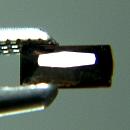|
|
||||||||||||||||
|
||||||||||||||||
|
||||||
|
|
|
|
Srilankite
|
|
| | |
| Discovered in 1982; IMA status: Valid (IMA Approved 1983) | ||
|
| ||
|
Chemistry |
|
|
| |
|
(Ti,Zr)O2 | |
|
|
Titanium Zirconium Oxide |
|
Molecular Weight: |
90.71 gm |
|
Composition: |
Zirconium |
25.14 % |
Zr |
33.96 % |
ZrO2 |
|
|
Titanium |
39.59 % |
Ti |
66.04 % |
TiO2 |
|
|
Oxygen |
35.27 % |
O |
|
|
|
|
|
100.00 % |
|
100.00 % |
= TOTAL OXIDE |
|
|
|
||||
|
Classification |
|
|
| |
|
Oxides | |
|
4/D.15-20 | |
|
|
4 : OXIDES (Hydroxides, V[5,6] vanadates, arsenites, antimonites,
bismuthites, sulfites, selenites, tellurites, iodates) |
|
Related to: |
Samarskite Group. Brookite - Kuranakhite Series |
|
Members of Group: |
Samarskite Group: Calciosamarskite, Ishikawaite, Samarskite-(Y), Samarskite-(Yb), Srilankite |
|
Varieties: |
None |
|
Synonyms: |
ICSD 69619, IMA1982-056, PDF 46-1265 |
|
|
|
|
Crystal Data |
|
|
|
|
|
Tabular crystals, often twinned. As idiomorphic inclusions, less than 1 mm, intergrown with associated minerals. |
|
|
Interpenetration and contact twins. |
|
|
|
|
|
Physical Properties |
|
|
|
|
|
Poor/indistinct in one direction |
|
|
Conchoidal |
|
|
Brittle |
|
|
~6.5; Vickers: VHN100=900-1000 kg/mm2 |
|
|
~4.60 (g/cm3) |
|
|
None |
|
|
Generally not radioactive but may be anomalously radioactive. |
|
|
|
|
|
Optical Properties |
|
|
|
|
|
Black, brownish black; dark blue in transmitted light; gray-white in reflected light. |
|
|
Opaque, translucent in thin fragments. |
|
|
Sub-metallic to adamantine |
|
|
2.380 Biaxial ( - ) |
|
|
0.000 (Isotropic) |
|
|
n/a |
|
|
None |
|
|
Observed; internal reflections: brown, dark blue |
|
|
|
|
|
Occurances |
|
|
|
|
|
Geological Setting: |
In pebbles found in concentrates from a placer gemstone mine. |
|
Common Associations: |
Zirconolite, Baddeleyite, Geikielite, Spinel, Perovskite |
|
Common Impurities: |
n/a |
|
Type Locality: |
Rakwana, Sabaragamuwa Province, Sri Lanka |
|
Year Discovered: |
1982; IMA approved 1983 |
|
View mineral photos: |
n/a |
|
|
|
|
More Information |
|
|
|
|
|
| |
|
|
|
|
Srilankite was
named in 1983 by Alexander Willgallis, Eveline Siegmann, and Theja
Hettiaratchi after its discovery locality at Rakwana, Sabaragamuwa
Province, Sri Lanka. This is also the only locality in
the world where Srilankite has been found.
|
|
|
We
have not photographed our Srilankite gems
yet. Please
check back soon. |
